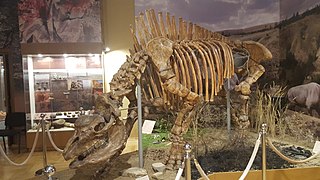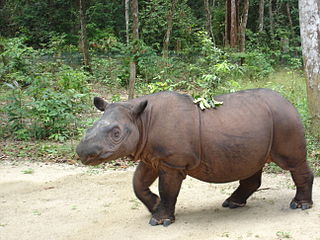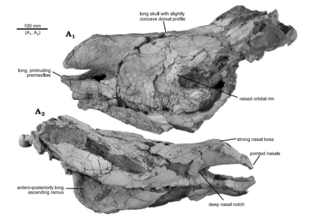
The Palearctic or Palaearctic is the largest of the eight biogeographic realms of the Earth. It stretches across all of Eurasia north of the foothills of the Himalayas, and North Africa.

Elasmotherium is an extinct genus of large rhinoceros that lived in Eastern Europe, Central Asia and East Asia during Late Miocene through to the Late Pleistocene, with the youngest reliable dates around 39,000 years ago. It was the last surviving member of Elasmotheriinae, a distinctive group of rhinoceroses separate from the group that contains living rhinoceros (Rhinocerotinae), with the divergence between Elasmotherium

The woolly rhinoceros is an extinct species of rhinoceros that inhabited northern Eurasia during the Pleistocene epoch. The woolly rhinoceros was a member of the Pleistocene megafauna. The woolly rhinoceros was covered with long, thick hair that allowed it to survive in the extremely cold, harsh mammoth steppe. It had a massive hump reaching from its shoulder and fed mainly on herbaceous plants that grew in the steppe. Mummified carcasses preserved in permafrost and many bone remains of woolly rhinoceroses have been found. Images of woolly rhinoceroses are found among cave paintings in Europe and Asia. The range of the woolly rhinoceros contracted towards Siberia beginning around 17,000 years ago, with the youngest known records being around 14,000 years old in northeast Siberia, coinciding with the Bølling–Allerød warming, which likely disrupted its habitat, with environmental DNA records possibly extending the range of the species around 9,800 years ago. Its closest living relative is the Sumatran rhinoceros.

The Sumatran rhinoceros, also known as the Sumatran rhino, hairy rhinoceros or Asian two-horned rhinoceros, is a rare member of the family Rhinocerotidae and one of five extant species of rhinoceros; it is the only extant species of the genus Dicerorhinus. It is the smallest rhinoceros, although it is still a large mammal; it stands 112–145 cm (44–57 in) high at the shoulder, with a head-and-body length of 2.36–3.18 m and a tail of 35–70 cm (14–28 in). The weight is reported to range from 500–1,000 kg (1,100–2,200 lb), averaging 700–800 kg (1,540–1,760 lb). Like both African species, it has two horns; the larger is the nasal horn, typically 15–25 cm (5.9–9.8 in), while the other horn is typically a stub. A coat of reddish-brown hair covers most of the Sumatran rhino's body.

Dicerorhinus is a genus of the family Rhinocerotidae, consisting of a single extant species, the two-horned Sumatran rhinoceros, and several extinct species. The genus likely originated from the Late Miocene of central Myanmar. Many species previously placed in this genus probably belong elsewhere.

Rhinoceros is a genus comprising one-horned rhinoceroses. This scientific name was proposed by Swedish taxonomist Carl Linnaeus in 1758. The genus contains two species, the Indian rhinoceros and the Javan rhinoceros. Although both members are threatened, the Javan rhinoceros is one of the most endangered large mammals in the world with only 60 individuals surviving in Java (Indonesia). The word 'rhinoceros' is of Greek origin meaning "nose-horn".

Coelodonta is an extinct genus of Eurasian rhinoceroses that lived from about 3.7 million years to 14,000 years ago, in the Pliocene and the Pleistocene epochs. It is best known from the type species, the woolly rhinoceros, which ranged throughout northern Eurasia during the Pleistocene. The earliest known species, Coelodonta thibetana, lived in Tibet during the Pliocene, with the genus spreading to the rest of Eurasia during the Pleistocene.

Mammuthus trogontherii, sometimes called the steppe mammoth, is an extinct species of mammoth that ranged over most of northern Eurasia during the Early and Middle Pleistocene, approximately 1.7 million to 200,000 years ago. The evolution of the steppe mammoth marked the initial adaptation of the mammoth lineage towards cold environments, with the species probably being covered in a layer of fur. One of the largest mammoth species, it evolved in East Asia during the Early Pleistocene, around 1.8 million years ago, before migrating into North America around 1.3 million years ago, and into Europe during the Early/Middle Pleistocene transition, around 1 to 0.7 million years ago. It was the ancestor of the woolly mammoth and Columbian mammoth of the later Pleistocene.

Cave hyena are extinct species or subspecies of hyena known from Eurasia, which ranged from Western Europe to eastern Asia and Siberia during the Pleistocene epoch. It is well represented in many European caves, primarily dating to the Last Glacial Period. It was an apex predator that preyed on large mammals, and was responsible for the accumulation of hundreds of large Pleistocene mammal bones in areas including horizontal caves, sinkholes, mud pits, and muddy areas along rivers.

The Ekityki is a stream located in Chukotka, in Far East Siberia. It belongs to the Chukotka Autonomous Okrug administrative region of Russia. It is 160 kilometres (99 mi) long, and has a drainage basin of 10,300 square kilometres (4,000 sq mi).

Stephanorhinus is an extinct genus of two-horned rhinoceros native to Eurasia and North Africa that lived during the Late Pliocene to Late Pleistocene. Species of Stephanorhinus were the predominant and often only species of rhinoceros in much of temperate Eurasia, especially Europe, for most of the Pleistocene. The last two species of Stephanorhinus – Merck's rhinoceros and the narrow-nosed rhinoceros – went extinct during the last glacial period.

Coelodonta thibetana, the Tibetan woolly rhinoceros, is an extinct species of the genus Coelodonta native to western Himalayas that lived during the middle Pliocene epoch. C. thibetana is known from the holotype IVPP V15908, a partially complete skull including incomplete lower jaw preserved with full dentition. It was first named by Tao Deng, Xiaoming Wang, Mikael Fortelius, Qiang Li, Yang Wang, Zhijie J. Tseng, Gary T. Takeuchi, Joel E. Saylor, Laura K. Säilä and Guangpu Xie in 2011.

The narrow-nosed rhinoceros, also known as the steppe rhinoceros is an extinct species of rhinoceros belonging to the genus Stephanorhinus that lived in western Eurasia, including Europe, as well as North Africa during the Pleistocene. It first appeared in Europe around 500,000 years ago during the Middle Pleistocene and survived there until at least 34,000 years Before Present. It was native to temperate and Mediterranean environments, where it fed on low growing plants and to a lesser extent woody plants. Evidence has been found that it was exploited for food by archaic humans, including Neanderthals.

Stephanorhinus kirchbergensis, also known as Merck's rhinoceros is an extinct species of rhinoceros belonging to the genus Stephanorhinus from the Early-Middle to Late Pleistocene of Eurasia. Its range spanned from Western Europe to Eastern Asia. Among the last members of the genus, it co-existed alongside Stephanorhinus hemitoechus in the western part of its range.

The Cave of Aroeira is an archaeological and paleoanthropological site in the Portuguese Estremadura Limestone Massif. The cave is located in the village of Almonda, in the civil parish of Zibreira, in the municipality of Torres Novas in the district of Santarém. The cave contained stones from the Paleolithic Acheulean culture, and the skull of Homo heidelbergensis, circa 400,000 years old. The discovery of Aroeira 3 was announced in spring 2017 - the earliest human trace in Portugal.
Dream Cave is a natural limestone cavern located near Wirksworth in Derbyshire, England. It was discovered by lead miners in 1822 and was found to contain the almost complete skeletal remains of a woolly rhinoceros and other large mammal bones. These remains were acquired by the geologist William Buckland and are now housed in Oxford Museum.

Homo longi is an extinct species of archaic human identified from a nearly complete skull, nicknamed 'Dragon Man', from Harbin on the Northeast China Plain, dating to at minimum 146,000 years ago during the Middle Pleistocene. The skull was discovered in 1933 along the Songhua River while the Dongjiang Bridge was under construction for the Manchukuo National Railway. Due to a tumultuous wartime atmosphere, it was hidden and only brought to paleoanthropologists in 2018. H. longi has been hypothesized to be the same species as the Denisovans, but this cannot be confirmed without genetic testing.

Dihoplus is an extinct genus of rhinoceros that lived in Eurasia from the Late Miocene to Pliocene.

Eoazara xerrii is a species of extinct elasmotheriine rhinoceros from the upper Miocene of Morocco, the first definitive representative of the subfamily in North Africa. It is known from a well preserved skull and postcranial material, preserving the most complete late Miocene rhino skull found in Africa.

Tolbaga is an archaeological site, located south of Lake Baikal, on the right bank of the Khilok river. It was excavated by Okladnikov circa 1970. The site is dated from bones to 34,860 ± 2100 BP and 27,210 ± 300 BP.



















